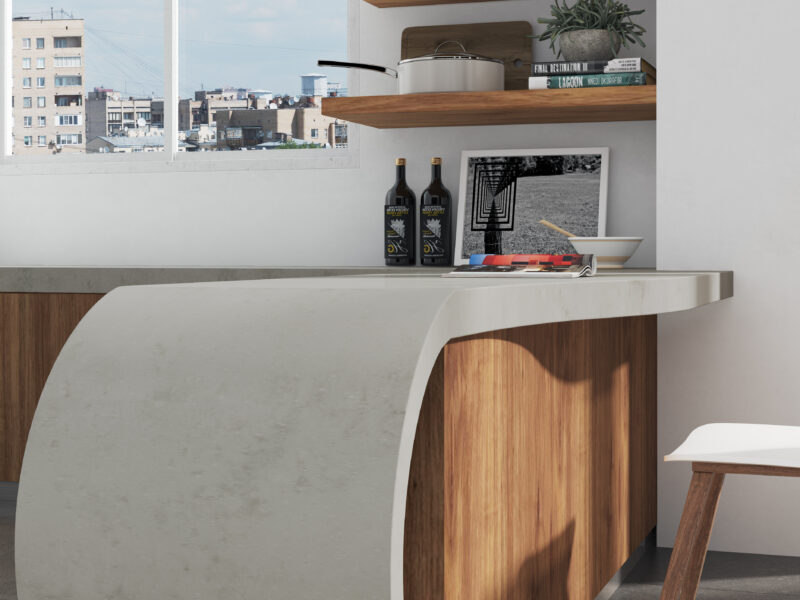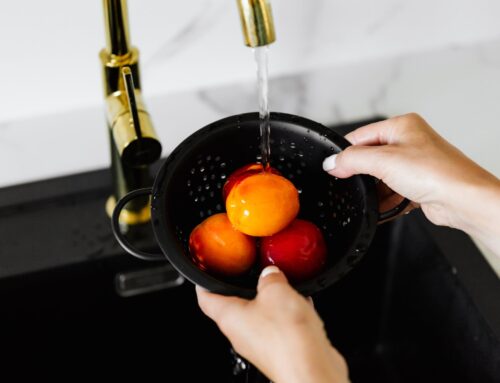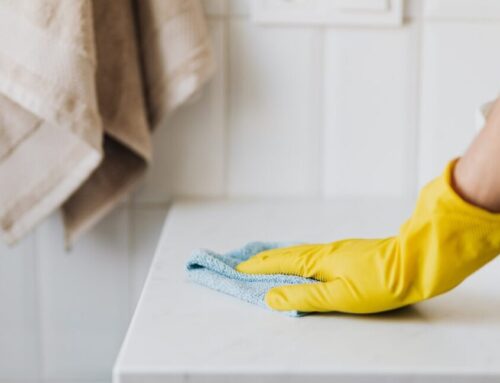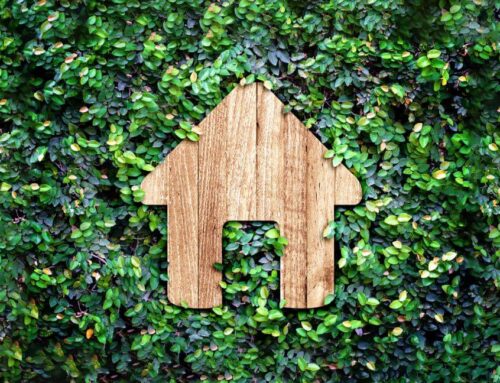The Federal Government has banned Engineered stone benchtops! Why? To protect workers from Silicosis and other diseases such as lung cancer, chronic bronchitis, emphysema, kidney damage, and scleroderma (scar tissue in joints, skin, and other organs) (Safe Work Australia 2023).
FROM JULY 1ST 2024, THE USE, SUPPLY, AND MANUFACTURE OF ENGINEERED STONE WILL BE PROHIBITED.
I have seen first-hand how devastating Silocosis can be. I performed chest X-rays and CT scans on young tradespeople who have only been working in the industry for 5 years, now only to find themselves debilitated by Silicosis. A few face the harsh reality of their diagnosis – a lung transplant or a very short life expectancy. Pretty scary stuff!
Crystalline Silica is a naturally occurring mineral and is commonly found in natural stone products, tiles, concrete, bricks, pavers, cement sheeting, and of course “man-made/engineered stone” benchtops. The increase in crystalline silica content in engineered stone means that when it is cut, drilled, or polished it releases fine silica dust which can lodge deep into the lungs when inhaled. Depending on the duration and intensity of exposure to the dust, these popular kitchen benchtops have left stonemasons with a potentially fatal disease. Different rocks have varying amounts of silica content. Engineered stone can have up to 97%, which is a lot compared to other rocks such as limestone which only has 2% (Safe Work Australia 2023).
Initially, new regulations and control measures were introduced in the workplace such as “wet cutting”, on-tool dust extraction systems, exhaust ventilation systems, and wearing masks/respirators; however, a report from Safe Work Australia has concluded that there is no “safe level” of crystalline silica content and therefore, even slabs with lower silica content could still pose a threat to workers. The first case of Silicosis in Australia associated with the fabrication of engineered stone benchtops was in 2015 and as of May 2022, there were at least 579 cases identified (Lung Foundation Australia 2023) and these numbers have continued to rise.
Acute exposure to high silica dust levels can affect workers within a matter of weeks to months. Silicosis causes lung inflammation and scarring and reduces the lung’s ability to take in oxygen (CDC 2023). Workers may experience a cough, shortness of breath, chest pain, and fatigue (CDC 2023). A study carried out by Monash University showed that High-resolution CT (HRCT) of the chest was the better imaging modality for screening this high-risk population compared to X-rays or respiratory lung function tests (Hoy et al. 2023).
If you need workplace testing, a certified Occupational Hygienist can carry out sampling for Respirable Silica Dust levels.
So, with the popular quartz-based products banned what other options have we got?
SOLID SURFACE
Solid surface benchtops are made from resins (acrylic, polyester or plastic) and natural minerals. Resin benchtops are durable, long-lasting, and non-porous therefore are resistant to bacteria and mould. Acrylic Solid surface products such as Corian, Meganite, Staron and Evostone are 100% silica-free benchtop options.
Meganite replicates the look and feel of real stone. It was founded in 1976 by a chemical engineer in Taiwan and is now made in the US. It’s GreenGuard and NSF-51 Certified (suitable for commercial food equipment materials). It is made up of alumina trihydrate (derived from bauxite ore), acrylic resin and colourant. Incorporating a Meganite basin or sink allows for a seamless integration. Currently, ForestOne is the sole distributor of Meganite in Australia which is committed to a net-zero future focusing on sustainable building and ethically sourced products.
Corian is manufactured in the US. It is waterproof and UV resistant and will never permanently stain as it can be repaired back to its original state. It is not considered as durable as a quartz-based benchtop and hot pans must not be placed on the surface. Corian is suitable for outdoor applications as it is resistant to environmental pollutants, freeze-thaw conditions, and humidity.
Staron is a product out of Korea and manufactured from refined bauxite (a silica-free mineral) and blended with pure acrylic resin. It contains aluminium hydroxide, Polymethyl methacrylate, pigments and additives. It is seamless in design due to its inconspicuous joining methods. It’s durable, non-porous, hygienic and UV stable. It can be moulded into curves or any desired shape. It doesn’t require polishes or sealants and can always be sanded back and restored to its original condition. The great thing about this material is that it can be repurposed into furniture or other new joinery.
Evostone silica-free solid surface benchtops have the look and feel of real quartz stone but are a much cheaper option. Made up of 15% methyl methacrylate homopolymer and >70% ingredients determined not to be hazardous. It is a much lighter material to work with and is heat-resistant, waterproof, hygienic, and durable. A non-porous material means that germs can’t penetrate the surface. It can be repaired or refurbished in the event of it being damaged. I have not had any experience with this product, however, do your research as it may be prone to scratches (especially gloss finish) if not cared for correctly.
PORCELAIN
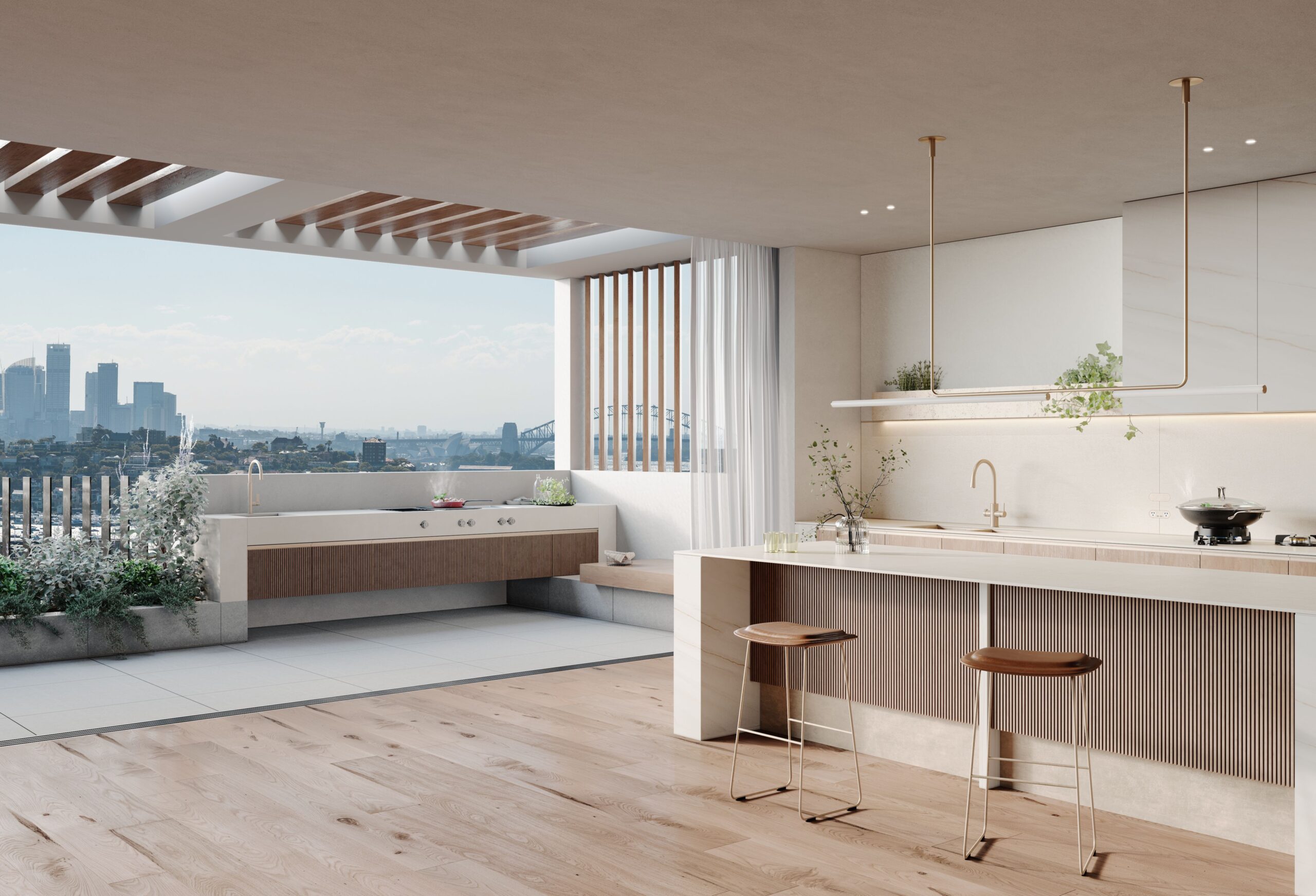
Caesarstone® Porcelain Beige Ciment™ and Sleet™, both suitable for indoor/outdoor use. Image courtesy of Caesarstone.
Porcelain benchtops are a “healthier” choice, however, can still have approximately 5-25% silica content. It is a 100% natural product made up of sand, clay, and quartz and can be recycled at the end of its use. It comes in thinner profiles making it light enough for vertical applications (splashbacks and wall cladding).
Caesarstone will be introducing new colour options in its Porcelain range which will be launched in March 2024. Caesarstone claims that you can cut directly onto the surface without causing harm to the benchtop. They also claim that hot pots can be placed directly onto the surface without worry. Pretty impressive right? It’s UV resistant and great for outdoors. It’s also resistant to food spills such as red wine (cheering). Caesarstone Porcelain slabs are made up of Feldspar (40-70%), Clay (20-40%), Quartz Silica Sand (<20%), and zircon (<12%) and come in honed or Ultra rough finishes. The percentage of ingredients may vary between products, so be aware of this.
Porcelain benchtops are virtually indestructible; however, they still have the potential for chipping and cracking if heavy objects are dropped on them. The main con – is a higher price tag.
STAINLESS STEEL
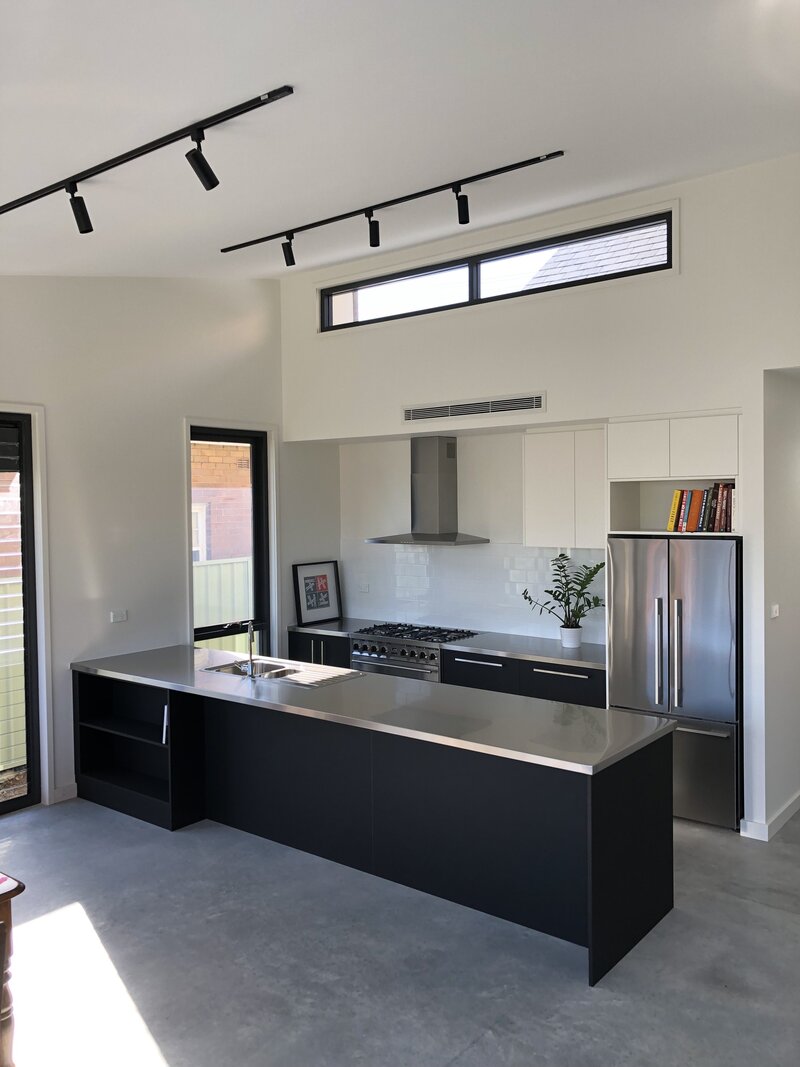
Stainless steel benchtop by Sydney based fabricator 'Martin Stainless Steel'
For a hard-wearing material that will stand the test of time, consider stainless steel. It’s hygienic, heat and stain-resistant and can take a bit of a beating in a hardworking kitchen. It will scratch easily, and you will see fingerprints, but hey, it adds character. Although Stainless Steel would complement an industrial-style kitchen, it can also be used in any modern or traditional home. Something to note is that a stainless-steel benchtop alongside an induction cooktop can produce very high magnetic fields when in use, and therefore I would not recommend this combination. Stainless steel is a sustainable material and 100% recyclable and reusable.
GLASS
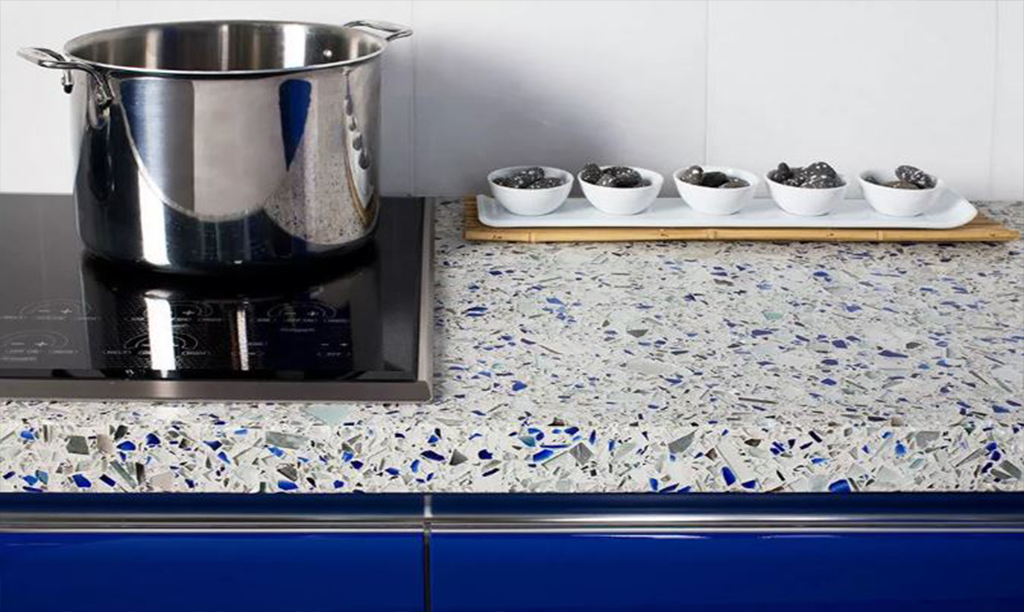
Vetrazzo Slab in 'Cobalt Sky' made of blue liquor bottles. Image courtesy of Stoneville Australia.
Glass benchtops come with many advantages – they are low maintenance, durable, easy to clean, and resistant to heat, stains, and scratches.
Vetrazzo is an eco-friendly option made up of 85% recycled glass mixed with a binder of pigments and additives. It is manufactured in the US and therefore has an increased embodied energy, which may be a consideration for those who are environmentally aware. These benchtops are brightly coloured and unique, adding some personality to any home. It can be used indoors and outdoors as it is heat and UV-resistant.
Betta Stone is a also fabulous alternative to engineered stone. It is Australian-made and owned, made from 100% recycled glass and contains <0.015% crystalline silica.
TIMBER
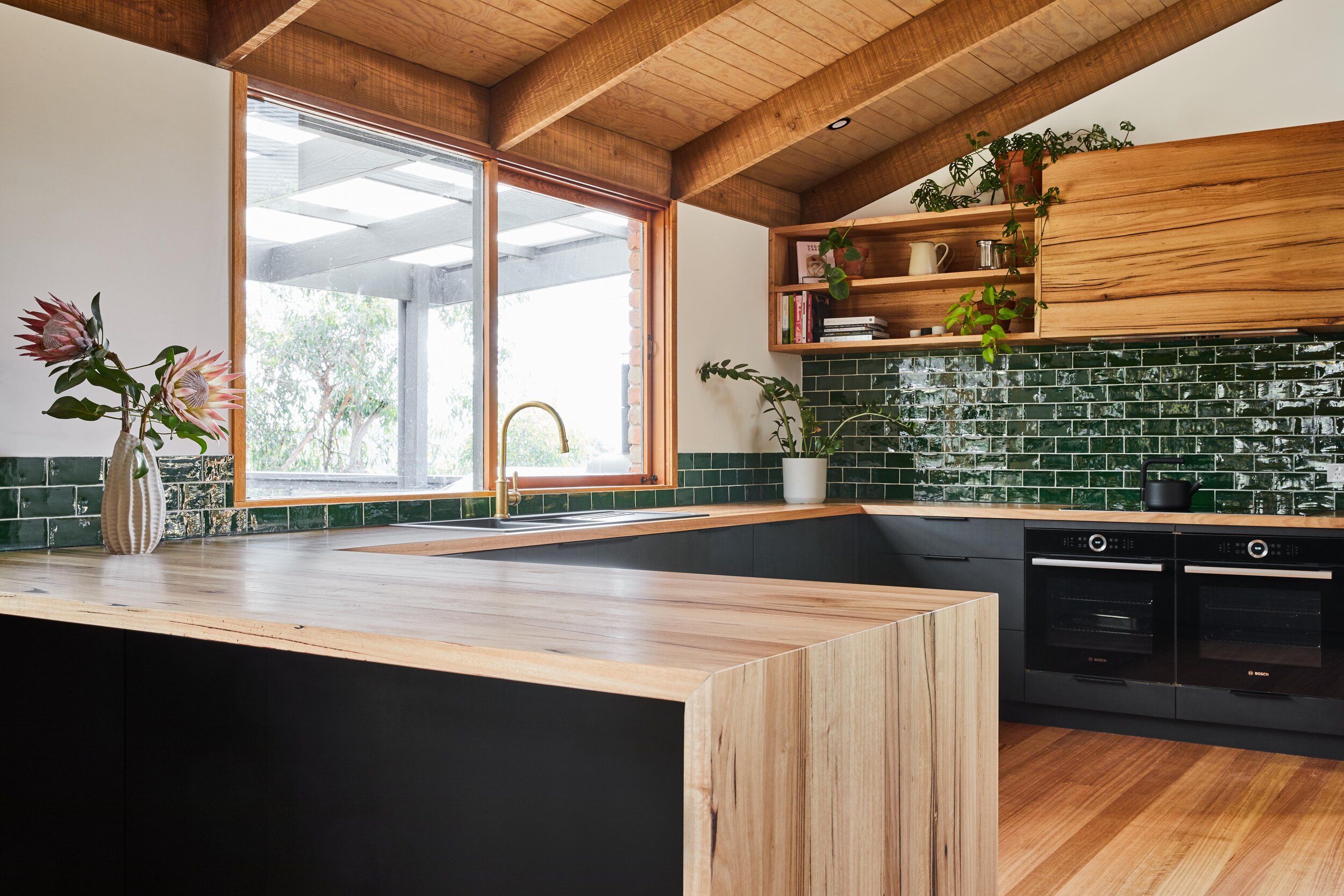
Messmate timber benchtop by Bombora Custom Furniture at their Anglesea House Project. Photo by Stephanie Rooney.
You can’t go past the beauty and warmth of timber in a home. With many species to choose from, you can achieve a variety of textures and colours. Timber gives a sense of belonging to the earth and would suit a biophilic design. They are a great “environmentally friendly” choice, however, they require some upkeep. As timber benchtops are quite porous they can be susceptible to stains and scratches. Sanding and regular oiling are required to keep them looking new and fresh. The bonus here is that you have the choice of selecting a non-toxic natural oil finish. Timber benchtops can be repurposed and used somewhere else in the home if you decide you no longer want them in your kitchen. Although timber adds a natural aesthetic, if you’re after a low-maintenance kitchen, you may want to consider other options.
SINTERED STONE
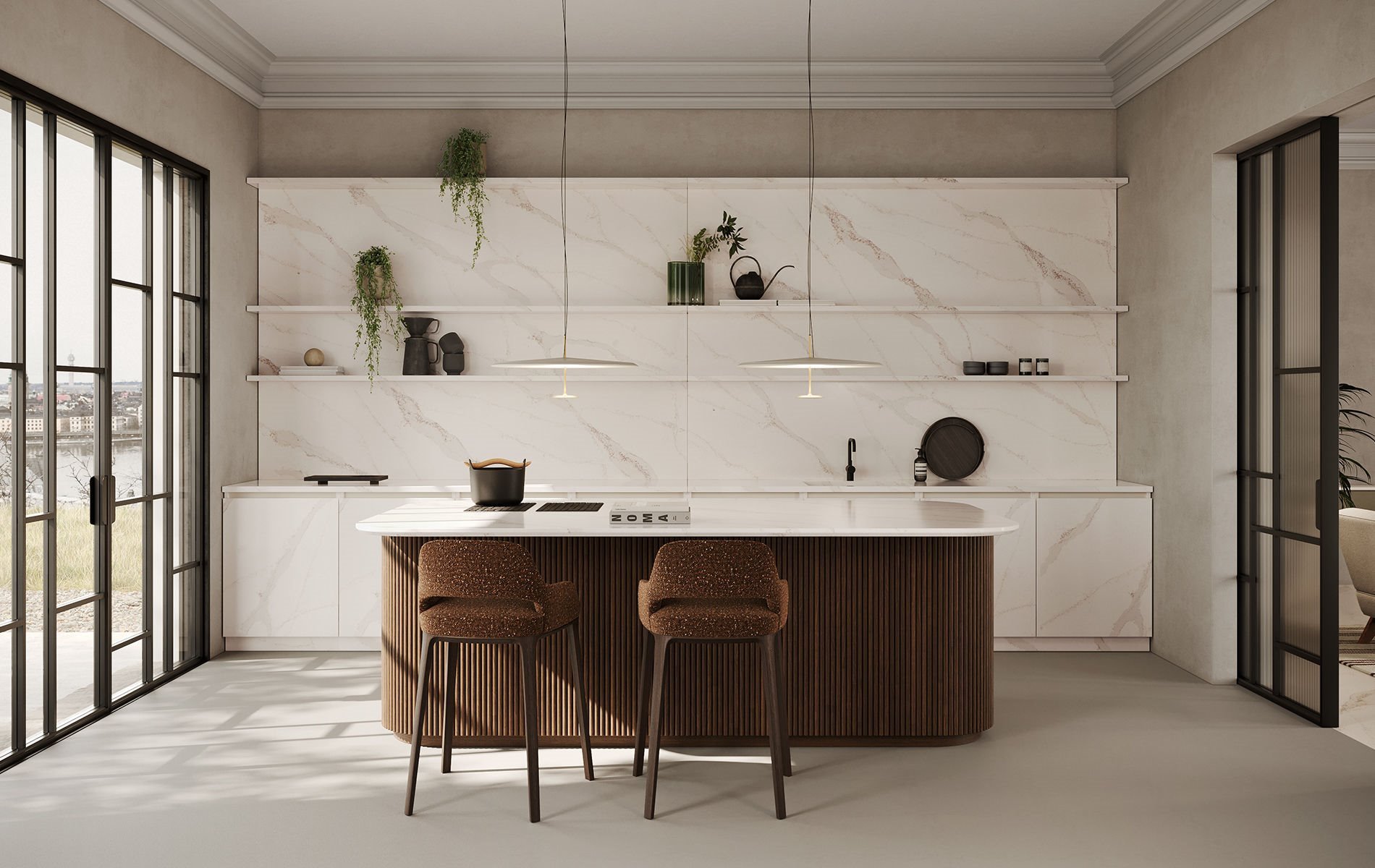
Lapitec featuring 'Bianco Alba'. Photo courtesy of Lapitec.
Sintered simply means the stone slab has been heated. Not all sintered stone benchtops are silica-free, however, I wanted to make special mention of a product out of Italy called Lapitec. It’s made with 100% natural minerals and has zero crystalline silica, resins, inks, or petroleum derivatives. It’s formed under high heat (the melting process is around 1600°C) and pressure and does not use varnishes or prints. It can be recycled at the end of its lifetime. Lapitec is certainly more environmentally aware, ensuring the finished product is completely inert and will not release harmful substances. It has achieved a Green Guard Gold Certification for the absence of VOC (Volatile Organic Compound) emissions. This is a thumbs up for air quality in the home. It can be used in many applications such as outdoor BBQs, wall cladding, swimming pools, yachts, and all kitchen surfaces. It can withstand high heat temperatures, is non-absorbent, and is resistant to scratches, acids, and other chemicals. It is the first and only product in the world to meet all the European Commission requirements. Lapitec is certainly a game changer but of course, you might need some spare coin for this one!
Smartstone’s Sintered collection will be launching in March 2024. Made from natural minerals with no quartz, resins, or metal; however, printing technology is used to achieve the natural stone look as opposed to using aggregates.
Neolith Iconic Design has zero silica content. It is a Spanish company with a distribution facility in Melbourne. This product is a glass ceramic composition with almost zero porosity and is heat, scratch, and stain resistant. It uses 3D printing technology with the advantage of integrating the design through the entire volume of the slab. Neolith are reducing their environmental impact by using 100% recycled water and 100% renewable energy during their production.
TERRAZZO
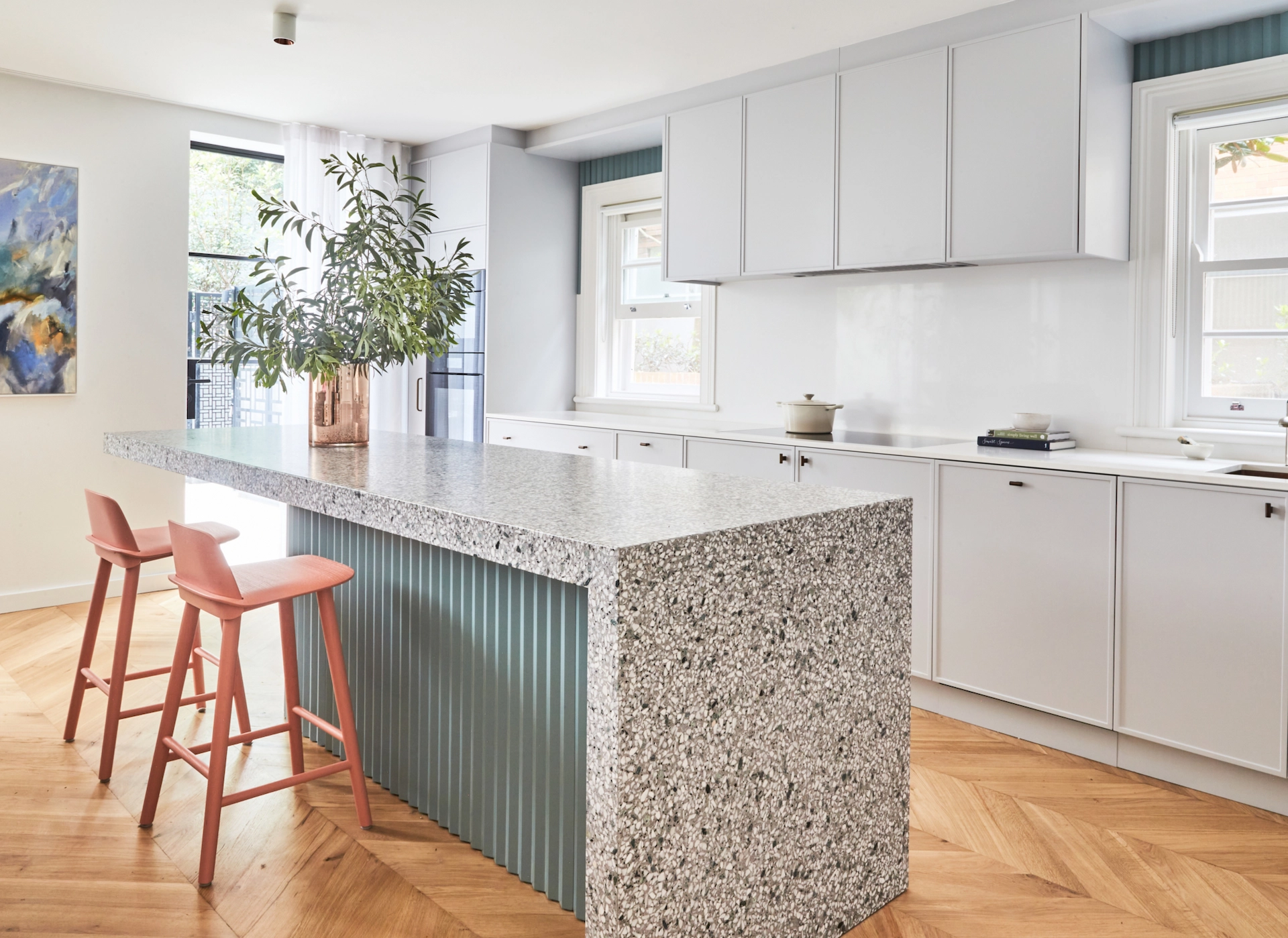
Fibonacci Terrazzo Slab in 'Deep Vault'. Photo by Simon Rose.
Terrazzo! You either love it or you hate it. In my opinion…its an oldie but a goodie because it has no VOCs and is eco-friendly, in that it uses recycled components. It is composed of calcium carbonate, portland cement, ferric oxide, marble chips, glass, and resin. It’s scratch-resistant and highly resistant to heat so it can handle hot objects placed directly onto it. It’s suitable for benchtops and splashbacks near hot ovens and stoves. It’s a great option for outdoors as it is also highly resistant to UV. Terrazzo may be difficult and costly to install. As with some other stone benchtops, their colour may fade over time, but be assured they can be polished, repaired, and restored to bring them back to life.
Fibonacci Terrazzo Stone is an Australian-owned company with products manufactured in Europe. They are composed of 75% up-cycled stone, are 100% recyclable, and contain no post-industrial waste. If you’re after a selection of beautiful and bold colours it’s one to check out.
CONCRETE
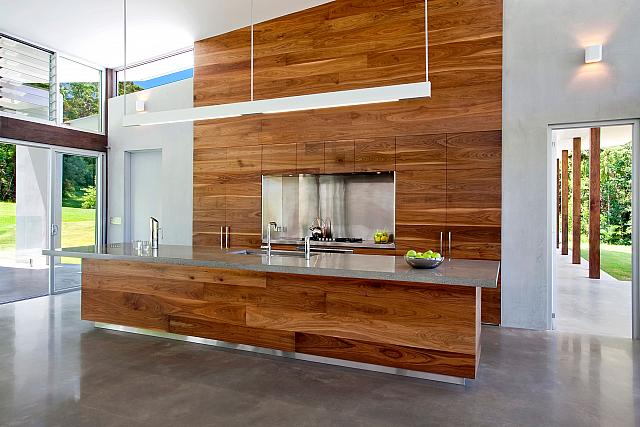
Custom made concrete benchtop by Mixed Element in 'Dark Grey'. Photo courtesy of Mixed Element
Ideal for an industrial look, concrete is a strong, long-lasting material that is virtually impervious to heat. When paired with timber, it’s hard not to fall in love with this look. Although some companies state hot pans can be placed directly onto the surface, I would avoid this due to the potential of “thermal shock” and cracking. Glass fiber-reinforced concrete can be coloured, polished, and moulded offering you a customized design to suit your taste. You will find that most concrete benchtop mixes no longer have any silica content in them. Concrete benchtops will require maintenance and a sealant to prevent moisture absorption and stains. It may become damaged over time as it is susceptible to chipped corners and edges.
NATURAL STONE
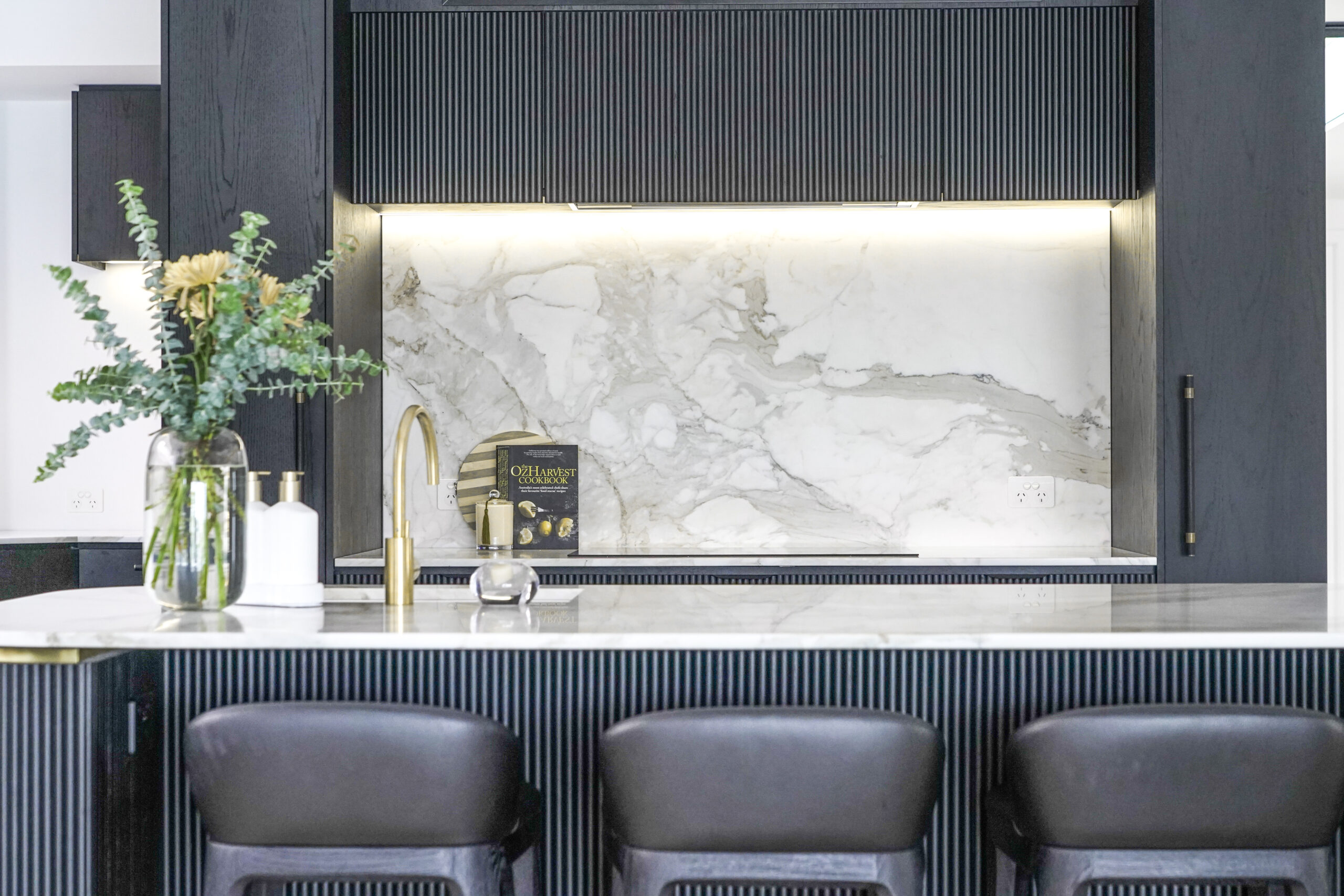
'Calacatta Oro' Marble slab. Photo by Isaiah Utama.
All natural stones are not created equal.
I do not recommend Granite as a natural stone as it not only has a higher silica content (25-45%) but can also emit low levels of radon into the home. Always check the Safety data sheet for each natural slab. Most marble and limestone slabs would contain <1% crystalline silica content so let’s take a look at them.
Marble Benchtops are heat resistant, can add a touch of luxury and elegance, and can come in a range of colours including black, pink, gold, and red. Although it is a beautiful lavish stone, it can be heavy, expensive, and not as environmentally friendly due to the extraction methods. It is also softer and permeable so surfaces may degrade over time if not well looked after. You should never chop directly on marble benchtops with knives.
Limestone Benchtops offer unique fossilization patterns. They require care and maintenance. It is not heatproof and more susceptible to scratching (nothing that chopping boards can’t prevent). Limestone is more porous and requires an infiltrating sealer (usually annually) to keep it looking flawless.
WOW, so we have quite a lot of options out there! Regardless of your choice, if you are handling or working with any building material, it is important to implement workplace health and safety measures and follow the guidance of material safety data sheets to mitigate risks.
ENJOY YOUR HAPPY HEALTHY HOME
CDC, 2023, Health Risks of Silica Exposure and Medical Monitoring. (Online). Available: https://www.cdc.gov/niosh/topics/silica/risks.html#:~:text=Breathing%20in%20dust%20from%20crystalline,This%20condition%20is%20called%20silicosis (20/01/2024).
Hoy, R.F, Dimitriadis, C., Abramson, M., Glass, D.C., Gwini, S., Hore-Lacy, F., Jimenez-Martin, J., Walker-Bone, K., Sim, M.R., 2023, Prevalence and risk factors for silicosis among a large cohort of stone benchtop industry workers. Occupational and Environmental Medicine. Vol. 80, No. 8, pp 439-446.
Hoy, R.F., Sim M.R. 2022, Correspondence on ‘Demographic, exposure and clinical characteristics in a multinational registry of engineered stone workers with silicosis’ by Hua et al. Occupational and Environmental Medicine. Vol. 79, No.9, pp 647-648.
Lung Foundation Australia, 2023, National Silicosis Prevention Strategy 2023-2028 and accompanying National Action Plan. Online. Available: https://lungfoundation.com.au/wp-content/uploads/2023/10/NSPS-NAP-Fifth-Full-Draft-Copy-for-Public-Consultation.pdf (18/01/2024).
Safe Work Australia, 2023 Crystalline silica and silicosis. Online. Available: https://www.safeworkaustralia.gov.au/safety-topic/hazards/crystalline-silica-and-silicosis (19/01/2024).
